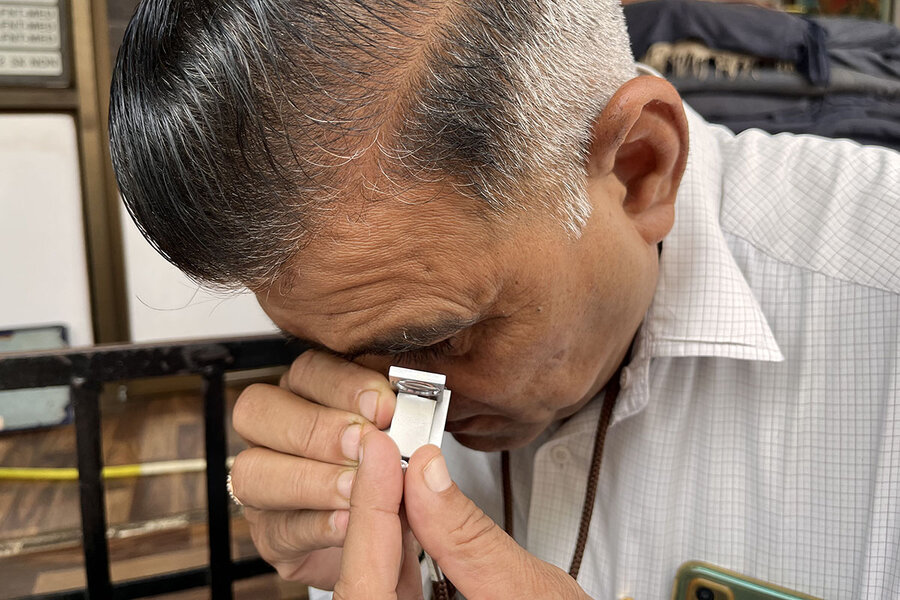How lab-grown diamonds are reshaping this western India city
Loading...
| Surat, India
An estimated 90% of the world’s diamonds are processed in the western Indian city of Surat, yet few come from Indian mines. Most rough gems are imported from countries such as Russia, and an increasing number are beginning life closer to home: in India’s new wave of state-of-the-art diamond labs.
Considered an ethical and affordable alternative to natural diamonds, lab diamonds are a burgeoning industry and the Indian government wants a slice. Leaders are promoting the shift, framing the influx of lab-grown diamonds, whose market share has more than doubled over the past year, as a way to shake India’s dependency on foreign suppliers.
Why We Wrote This
A story focused onIndia sees lab-grown diamonds as a path to prosperity and economic independence. But for Surat’s diamond workers, the picture is more complex. Can the industry become profitable for all?
But while some hail the synthetic gems for democratizing a luxury item, others fear their over-supply is bad news in an already slow market. In Surat, opinion is divided over whether this shift is helping or hurting those in the middle, particularly the city’s diamond polishers.
“We do get some employment because of lab-grown diamonds, but their future isn’t secure,” says Bhavesh Tank, vice president of the diamond workers’ union in Surat, who wants the government to put a cap on the number of lab-grown diamonds entering the market. “What is real is real, demand for natural diamonds will bounce back.”
You can’t say the same about lab-grown diamonds, he adds.
In a warren of narrow lanes in western India, almost every man carries a paper pouch in his pocket full of glittering diamonds. Among them is Nagji Rawal.
Back at his shop, the diamond broker sits cross-legged with a velvet jewelry tray perched on his lap. Using his thumb and middle finger, he gingerly picks up a tiny diamond and brings it to eye level, peering at it through an eyepiece that he wears on a long rope around his neck.
An estimated 90% of the world’s diamonds are processed here in Surat, India, yet few come from Indian mines. Most of the diamonds that pass through Mr. Rawal’s shop are imported from mine-rich countries such as Russia or Botswana, but this batch began life closer to home – specifically, in India’s new wave of state-of-the-art diamond labs.
Why We Wrote This
A story focused onIndia sees lab-grown diamonds as a path to prosperity and economic independence. But for Surat’s diamond workers, the picture is more complex. Can the industry become profitable for all?
Friendlier to the environment and consumers’ wallets, lab diamonds are a burgeoning industry and the Indian government wants a slice.
Leaders are promoting the shift, framing the influx of lab-grown diamonds, whose market share has more than doubled over the past year, as a way to shake India’s dependency on foreign suppliers. But while some hail the synthetic gems for democratizing a luxury item, others fear their over-supply is bad news in an already slow market. On the streets of Surat, opinion is divided over whether this shift is helping or hurting those in the middle.
“We do get some employment because of lab-grown diamonds, but their future isn’t secure,” says Bhavesh Tank, vice president of the diamond workers’ union in Surat. “What is real is real, demand for natural diamonds will bounce back.”
You can’t say the same about lab-grown, he adds.
The allure of lab diamonds
Lab-grown diamonds are seen as an ethical alternative to natural diamonds, whose mining has been linked to human rights abuses in several countries. They also cost about a third of the price of regular diamonds, despite being virtually identical in look and feel. Even veteran diamantaires can’t tell them apart without specialized equipment.
“Earlier, only the rich could afford to wear a diamond, but now, the poor can also fulfill their dreams,” says Mr. Rawal, who believes that lab diamonds are here to stay. He says most people coming to him these days ask for lab-grown.
Diamond trader Siddharth Parekh, who’s based just a few blocks away, says that five years ago, very few people knew about lab diamonds. In the past year or so, awareness among both customers and traders has increased. “The market has changed,” he says, adding that he can envision India’s lab-grown diamonds being useful not only to jewelers, but also in medical and drilling industries.
As the popularity of lab-grown diamonds soars worldwide, India is eyeing a larger share of the market, which is currently dominated by China. Whereas China produces diamonds mainly using the high-pressure, high-temperature method, India is emerging as a leader in another technique called chemical vapor deposition. In the 2023-2024 budget, India’s government removed the 5% customs duty on seeds, the starting material used to make lab diamonds, and announced a $29 million research grant to a top university to promote domestic diamond manufacturing.
When Prime Minister Narendra Modi visited the White House this summer, he gifted first lady Jill Biden a 7.5-carat diamond grown by the Surat-based firm Greenlab. The company pivoted from natural to lab diamonds four years ago.
From his swanky office in Surat, Greenlab director Smit Patel describes how a few companies control the supply of mined diamonds. Lab diamonds break that monopoly, he says, and are the “pinnacle” of Atmanirbhar Bharat, or self-reliant India, a central motto of the Modi government.
“We can grow our own rough, we can cut and polish in India, we can set jewelry in India, and we can export it around the world,” Mr. Patel says.
But some argue that the enthusiasm for lab diamonds has gone too far.
A demand-supply mismatch
The synthetic gems have, at times, been a boon for laborers. When the Ukraine war broke out and sanctions disrupted the supply of rough diamonds from Russia, Mr. Rawal says lab-grown diamonds kept Surat’s artisans afloat.
Yet increased production of lab diamonds has resulted in abundant supply even as demand in the West remains sluggish, causing all diamond prices to drop. That doesn’t bode well for the diamond industry, particularly its most vulnerable workers: diamond polishers.
“High inventory of polished diamonds amid falling retail prices will put the profitability of polishers under the pump,” said a recent press release by the rating agency CRISIL, noting that polished diamonds have become 10-15% cheaper.
“We see the Indian diamond industry shrinking by over a third on an annualized basis this fiscal,” its director Rahul Guha noted.
For months, laborers have been coming to Mr. Tank, the union leader, with complaints about reduced wages and late payments. He says 32 workers have died by suicide since July. Mahesh Singh, who has been polishing diamonds for the past 30 years, reports that his income has nearly halved.
The main problem, he says, is low demand. In addition to reduced demand from India’s main markets in the West, turmoil in Israel, another big customer, is making Surat’s diamond industry jittery. Workers are also paid per carat, and while there shouldn’t be much difference in wages between natural and synthetic diamonds, Mr. Singh says lab-grown diamonds are sometimes harder, and therefore take longer to finesse. That means polishers get paid less for the same amount of hours at the wheel.
Although lab-grown diamonds brought the city much-needed work when rough diamond supplies were disrupted, Mr. Tank says the government must now step in to regulate. “They should put a limit on the number of lab-grown diamonds coming into the market,” he insists.
But Mr. Patel of Greenlab says India can’t afford to pull the reins while China is also trying to capture the market.
Vipul Shah, chair of India’s Gem and Jewellery Export Promotion Council, notes that reliable data on lab-grown diamonds and their impact on the gem market is hard to find.
“It’s a new segment, and since a lot of new plants have been put up, we are not sure whether it’s oversupply,” he says. But he isn’t worried. He believes the “lab-grown diamond segment is going to be complementing the natural,” rather than competing.
Shantanu Guha Ray, author of “The Diamond Trail: How India Rose to Global Domination,” agrees.
Lab-grown diamonds are “the number two diamond preference for people who genuinely love diamonds,” he says. “The real diamond is a real diamond.”
While synthetic diamonds may never outshine the natural ones, some in Surat feel they are dimming their sparkle. Alpesh Shah, who trades exclusively in natural diamonds, says the overwhelming availability of lab diamonds has contributed to a downturn in his business, with more customers choosing the affordable alternative.
And if everyone has a diamond, Mr. Shah says, it will no longer be considered precious.












